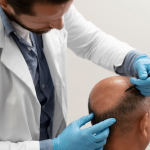Side Effects of Hair Transplant Surgery & Recovery
Hair transplant surgery is one of the best methods to help people regain fuller and healthier hair growth. However, some hair transplant surgeries have side effects.
So, if you want to know about the potential side effects of hair transplant surgery along with recovery time, then this blog is only for you.
In this post, we shall discuss everything you have to know about hair transplant surgery, including the side effects and recovery time.
Let’s get started…
Side Effects of Hair Transplant Surgery Executed by any Technique
Hair Shedding
No, hair shedding and hair loss are not the same, and this is why!
Listen to Dr. Kuntal Deb Barma, Medical Director at DHI Group talking about this in detail.
At DHI Hair Transplant clinics, we help you by giving you the best possible solution to restore your hair and your peace. Direct Hair Implantation – DHITM is the world’s most advanced, effective, and painless Hair Transplant Technique. Safety, Maximum Density, and 100% Natural Results are the DHI hair transplant technique objectives. An excessive amount of hair shedding within 2-3 months is a common adverse effect that can occur after a hair transplantation procedure. Hair shedding may occur on the recipient and donor area due to vascular disruption and surgical stress. In some cases, the patient may experience hair loss after the procedure.
Scars
Scarring is another possibility post-hair transplant surgery. It can occur in the donor location and recipient location (the area that will receive the transplant). Some techniques, such as FUT and FUE, typically result in a lengthy and linear scar. It is because in the FUT technique, the surgeon removes a strip of the patient’s scalp and in the FUE technique the surgeon executes slits from a sharp blade while doing implantation.
However, the scar becomes less noticeable once you start to regain your hair in that area. It remains visible during healing time, which causes problems for some patients, especially when they go out for work.
Bleeding
No matter the hair transplantation method, bleeding occurs because excluding the DHI technique in other hair transplant techniques involves cuts. However, a professional surgeon will always take precautions so that there is less bleeding during the procedure. Even after the hair transplant procedure is complete, some individuals may continue to have some degree of bleeding. If you also face bleeding issues for a long time, it’s advised to see your surgeon immediately.
Bumps
Individuals may sometimes develop raised bumps around the area where transplantation occurred. However, as the healing process progresses, these bumps will eventually disappear.
Aching
Some individuals may even experience aching and swelling post-hair transplant surgery. If this is the case with you too, then visit your surgeon. Your surgeon may prescribe pain medicines to control any kind of pain or discomfort.
Swelling
Swelling, often known as edema, is a typical side effect of hair transplant surgery. As the skin heals, the individual may experience some swelling in the head and face. To some extent, it is normal. However, if the situation gets worse for you, do visit your surgeon so that they can help you with the problem.
Inflammation
Inflammation is also one of the side effects of hair transplant surgery. A severe form of sterile folliculitis, Lichen planopilaris is a rare inflammatory hair illness that affects only a very small percentage of people.
Infections
Some people may even develop an infection close to the donor or recipient area. Inadequate sanitation of the scalp might result in the development of localized infections in both the donor and recipient areas. That is why it is essential that you follow the aftercare regime religiously. Choose the best hair transplant technique for your hair transplant procedure.
Pain
Hair transplantation is an invasive surgical procedure. Surgeons administer anesthesia to reduce or eliminate discomfort during surgical procedures. However, if insufficient anesthesia is administered, the patient may experience terrible pain. Due to the region’s stretching, individuals may experience discomfort around the area where hair transplantation was performed on occasion.
Itching
Itching is also one of the side effects of hair transplant surgery. Surgery on any part of the body almost always results in some degree of itching as the region heals. However, the itching will stop for good once the wound has healed. Scabs’ formation on the newly transplanted scalp causes itching.
Numbness
Patients are given local anesthesia before the hair transplant surgery is performed, which leads to numbness in the treated area. As the effects of the anesthesia wear off, the numbness will begin to subside.
So, these are the potential side effects of hair transplant surgery. Remember that not every patient experiences these side effects or the same effects. Also, several different kinds of hair transplant surgeries lead to different side effects. However, it is essential to be aware of all the potential side effects before undergoing hair transplant surgery. It is advised to speak with your surgeon and ask every sort of question you might have regarding the hair transplant surgery. Checking to see if you are an excellent candidate for hair transplantation is always wise.
Recovery Time
After a hair transplant treatment is complete, the next stage is the healing period. It’s a critical passé after hair transplant surgery. Recovery time varies from patient to patient based on several factors, including the type of technique, and the number of hairs implanted in hair transplant surgery you have undergone.
This is the time when you have to be extra cautious and follow all of the aftercare instructions provided by your hair transplant surgeon. Given the physical demands of a hair transplant, it is essential that you have access to post-operative care. Post-operative care is essential for every patient who undergoes hair transplant surgery to avoid undesirable outcomes or post-operative side effects.
Why is Direct Hair Implantation – DHITM the Best Hair Transplant Surgery in the World?
As we discussed above, hair transplant techniques and surgeries have side effects; after knowing about these side effects, most people change their minds and give up on their decision to hair transplantation.
But we all know that hair plays a crucial role when it comes to looking presentable and confident. That’s when Direct Hair Implantation (DHITM) comes into play. Direct Hair Implantation (DHI) technique introduced by DHI Medical Group in 2005 is one of the best hair transplant techniques today. Here are some of the best benefits of getting DHI hair transplant treatment:
- DHI is one of the most advanced hair transplantation techniques.
- It is the least invasive hair transplant technique. In this technique, individual hair follicles are implanted directly into the balding region that needs to be covered.
- Everything from angle to depth to direction is considered while implanting hair follicles. The DHI implanter is a patented device that is used to implant hair follicles and that gives better control at a precise direction, angle, and depth to get the most natural appearance and longest lifespan possible hair results.
- Hair implants stay in place permanently and continue to grow throughout a person’s life.
- The coolest thing about the Direct Hair Implantation technique is that it has no side effects.
- The entire hair transplant procedure is carried out by surgeons only who have been trained and certified by the DHI London Hair Restoration Academy, the only academy in the world specializing in hair restoration.
- DHI surgeons follow stringent DHI quality standardization protocols that DHI has established to guarantee excellent results every time.
All in all, Direct Hair Implantation – DHITM is one of the best hair transplant techniques to restore fuller and healthier hair growth. Because it has no side effects, it is the go-to option for people who want to get a hair transplant procedure.
So, if you’re planning to get hair transplant surgery, try the DHI hair transplant technique for the best outcomes!







